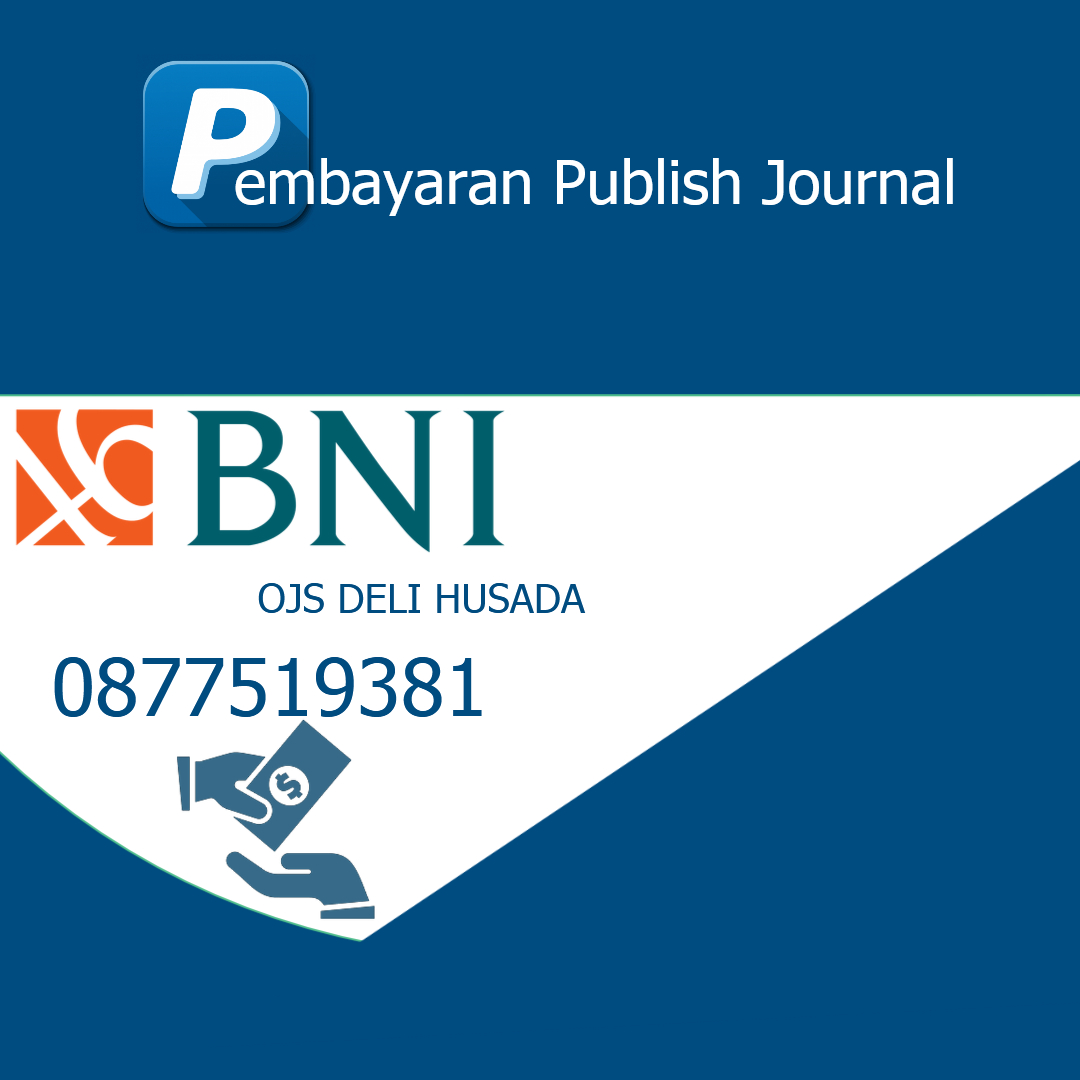FAKTOR-FAKTOR TERKAIT KEPATUHAN KEPERAWATAN DALAM PELAKSANAAN STANDAR PELAYANAN RSU AL-AZIS
Keywords:
Compliance, Nurse, Appliying of Universal / Standar Precautions
Abstract
Universal / Standard Precautions are recommended to prevent exposure to blood-borne infectious diseases such as HIV, Hepatitis B Virus, and Hepatitis Virus in health services, in Elpi Al-Azis General Hospital Rantauprapat, the compliance with Universal / Standard Precautions among nurses is low, it can be seen from accident cases syringes that occurred among nurses in 2007-2019 were 6, 4, and 8 cases respectively. This study was an Analytical Survey using a cross sectional design with 60 respondents as a population and 52 nurses as sample.From the results of the chi square test, the variables significantly associated with nurse compliance with the application of universal / standard precautions are knowledge p value = 0.003,perception of risk p value = 0.001,Barriers to risk p value = 0.008, Perception regarding policy p value = 0.004, workload p value = 0.001, training and availability of Private Protective Equipment p Value 0.010. By analyzing with multivariate show that there is the most dominant variable is workload p value = 0.042, Exp (B) = 4.973 with CI 95% (0.835- 23.253). From the results of the study it can be concluded that there is a significant relationship between perceptual factors and workload factors regarding policy with nurse compliance in the implementation of universal / standard precautions in Elpi Al-Azis Hospital Rantauprapat in 2019. It is expected that there is a policy from Hospital management in implementing workload so that nurses' perceptions have a positive impact on carrying out tasks systematically.References
Albery, Iann P. and Marcus Munafo.2008. Key Concepts in Health Phychology. London: SAGE Publication
Basuki, Endang dan Hadi S. Topobroto. 2007. Advokasi sebagai Usaha untuk Membangun Budaya Keselamatan dan Kesehatan Kerja di Masyarakat. Majalah Kedokteran, 57 (3): 135 -139.
Benedetto, et.al. 2011. What causes an improved safety climate among staff of a dyalisis unit? Report of an evaluation in a large network. JNEPHROL, 34 (05): 604-612.
Brevidelli, Maria Meimei and Tamara Iwanow Cianciarullo. 2009. Rev Saude Publica, 43 (9): 1-10.
CDC. 2007. Guideline for Isolation Precautions: Preventing Transmission of Infectious Agents in Healthcare Setting, http://cdc.gov/hicpac/pdf/isolation/isolation2007.pdf (16 Januari2019).
Corwin, Elizabeth J. 2000. Buku Saku Patofisiologi (Terj. dari Handbooks of Pathophysiology, Brahm U. Pendit). Jakarta : EGC
DeJoy, David M. Lawrence R. Murphy & Robyn M. Gershon.1995. TheInfluence of employee, job/task, and organizational factors on adherence touniversal precautions among nurses. International Journal of Industrial Ergonomics 16: 43-55.
DeJoy, David M. 1996. Theoretical Models of Health Behavior and Workplace Self-Protective Behavior. Journal of Safety Research, 27 (2) : 61-72
DeJoy, David M., Cynthia A. Searcy & Lawrence R.Murphy. Behavioral- Diagnostic Analysis of Compliance With Universal Precautions Among Nurses.
Depkes. 2003. Pedoman Pelaksanaan Kewaspadaan Universal. Jakarta: Depkes RI.
Duerink, D.O., et.al. 2006. Preventing nosocomial infections: improving compliance with standard precautions in an Indonesian teaching hospital.Journal of Hospital Infection (64): 36 -43.
Efstathiou, Georgios, Evridiki Papastavio, Vasilios Raftopoulos, Anastasios Merkouris. 2011. Factors Influencing Nurses’ Compliance with Standard Precautions in order to Avoid Occupational Exposure to Microorganisms: A Focus Group Study. BMC Nursing, 10 (1):1-12.
Emaliyawati, Etika. 2009. Makalah. Tindakan Kewaspadaan Universal Sebagai Upaya untuk Mengurangi Risiko Penyebaran Infeksi. Universitas Padjadjaran.
Feyer, Anne-Marie and Ann Williamson (ed). 1998. Occupational Injury: Risk, Prevention, and Intervention. UK: Taylor and Francis
Green, Laurence, W. et.al. 1980. Health Education Planning: A Diagnostic Approach, California: MayfieldPublisher.
Hastono, Sutanto Priyo. 2007. Modul Analisis Data Kesehatan. Universitas Indonesia: Fakultas KesehatanMasyarakat
Hastono, Sutanto Priyo dan Luknis Sabri. 2008. Statistik Kesehatan.Jakarta: Rajawali Pers.
Janjua, Naveed Z., et.al., 2007. Poor Knowledge – Predictor of Nonadherence to Universal Precautions for Blood Pathogens at First Level Care Facilities Pakistan. BMC Infectious Diseases, 7 (81).
Kermode, Michelle, et.al., 2005. Compliance with Universal/Standard Precautions among Health Care Workers in Rural North India. AIIC, 33 (1): 27-33.
Levenson, Michael. 1990. Risk Taking and Personality. Journal of Personality and Social Psychology, 58 (6): 1073-1080
Mehta, A., et.al., 2010. Interventions to Reduce Needlestick Injuries at A Tertiary Care Centre. Indian Journal of Medical Microbiology, 1 (28): 17-20.
Murti, Bhisma. 2010. Desain dan Ukuran Sampel untuk Penelitian Kuantitatif dan Kualitatif di Bidang Kesehatan. Yogyakarta: Gajah Mada University Press
Niven, Neil. 2000. Psikologi Kesehatan : Pengantar untuk Perawat dan Profesional Kesehatan Lain (Terj. Agung Waluyo). Edisi ke-2. Jakarta: ECG
Notoatmodjo, Soekidjo, 2007. Promosi Kesehatan dan Ilmu Perilaku. Jakarta: Rineka Cipta.
Nursalam dan Ninuk Dian Kurniawati, 2011. Asuhan Keperawatan pada Pasien Terinfeks. Edisi Pertama. Jakarta: Salemba Medika.
Pinem, Saroha. 2003. Tesis. Penerapan Kewaspadaan Universal oleh Bidan dan Faktor-Faktor yang Berhubungan di Puskesmas Kecamatan Wilayah Jakarta Timur Tahun 2003. Universitas Indonesia: Fakultas Kesehatan Masyarakat.
Reda, Ayalu A., Shiferaw Fisseha, Bezaty Mengistie, Jean-Michel Vandeweerd. 2010. Standard Precautions: Occupational Exposure and Behavior of Healthcare Workers in Ethiopia. PLoS ONE, 5 (12).
Sadoh, Wilson E., et.al., 2006. Practice of Universal Precautions among Healthcare Worker.Journal of The National Medical Association, 98 (5): 727 – 726.
Environmental Health & Safety. Sharp Safety. http://utexas.edu/safety/ehs (10 Januari 2019).
Smet, Bart. 1994. Psikologi Kesehatan. Jakarta: PT Grasindo
Sulastri. 2001. Tesis.Faktor-faktor yang Berhubungan dengan Tingkat Kepatuhan Petugas Kamar Bedah dalam Menerapkan Kewaspadaan Universal di Rumah Sakit Umum Pusat Persahabatan Tahun 2001. Universitas Indonesia: Fakultas Kesehatan Masyarakat.
Tull, Matthew, 2009. Risk Taking, http://ptsd.about.com(19 Januari 2019).
Weston, Debbie. 2008. Infection Prevention and Control: Theory and Clinical Practice for Healthcare Professionals. England: John Wiley & Sons, Ltd.
WHO. 2008. Penerapan Kewaspadaan Standar di Fasilitas Pelayanan Kesehatan.
WHO.2010.WHObestpracticesforinjectionsandrelatedprocedurestoolkit, http://whqlibdoc.who.int/publications/2010/9789241599252_eng.pdf (16Januari 2019).
Yayasan Spiritia. 2009. Kewaspadaan Universal. http://spriritia.or.id/ (13 Januari, 2019).
Yayasan Spiritia. Infeksi Nosokomial dan Kewaspadaan Universal. http://spriritia.or.id/(13 Januari, 2019)
Basuki, Endang dan Hadi S. Topobroto. 2007. Advokasi sebagai Usaha untuk Membangun Budaya Keselamatan dan Kesehatan Kerja di Masyarakat. Majalah Kedokteran, 57 (3): 135 -139.
Benedetto, et.al. 2011. What causes an improved safety climate among staff of a dyalisis unit? Report of an evaluation in a large network. JNEPHROL, 34 (05): 604-612.
Brevidelli, Maria Meimei and Tamara Iwanow Cianciarullo. 2009. Rev Saude Publica, 43 (9): 1-10.
CDC. 2007. Guideline for Isolation Precautions: Preventing Transmission of Infectious Agents in Healthcare Setting, http://cdc.gov/hicpac/pdf/isolation/isolation2007.pdf (16 Januari2019).
Corwin, Elizabeth J. 2000. Buku Saku Patofisiologi (Terj. dari Handbooks of Pathophysiology, Brahm U. Pendit). Jakarta : EGC
DeJoy, David M. Lawrence R. Murphy & Robyn M. Gershon.1995. TheInfluence of employee, job/task, and organizational factors on adherence touniversal precautions among nurses. International Journal of Industrial Ergonomics 16: 43-55.
DeJoy, David M. 1996. Theoretical Models of Health Behavior and Workplace Self-Protective Behavior. Journal of Safety Research, 27 (2) : 61-72
DeJoy, David M., Cynthia A. Searcy & Lawrence R.Murphy. Behavioral- Diagnostic Analysis of Compliance With Universal Precautions Among Nurses.
Depkes. 2003. Pedoman Pelaksanaan Kewaspadaan Universal. Jakarta: Depkes RI.
Duerink, D.O., et.al. 2006. Preventing nosocomial infections: improving compliance with standard precautions in an Indonesian teaching hospital.Journal of Hospital Infection (64): 36 -43.
Efstathiou, Georgios, Evridiki Papastavio, Vasilios Raftopoulos, Anastasios Merkouris. 2011. Factors Influencing Nurses’ Compliance with Standard Precautions in order to Avoid Occupational Exposure to Microorganisms: A Focus Group Study. BMC Nursing, 10 (1):1-12.
Emaliyawati, Etika. 2009. Makalah. Tindakan Kewaspadaan Universal Sebagai Upaya untuk Mengurangi Risiko Penyebaran Infeksi. Universitas Padjadjaran.
Feyer, Anne-Marie and Ann Williamson (ed). 1998. Occupational Injury: Risk, Prevention, and Intervention. UK: Taylor and Francis
Green, Laurence, W. et.al. 1980. Health Education Planning: A Diagnostic Approach, California: MayfieldPublisher.
Hastono, Sutanto Priyo. 2007. Modul Analisis Data Kesehatan. Universitas Indonesia: Fakultas KesehatanMasyarakat
Hastono, Sutanto Priyo dan Luknis Sabri. 2008. Statistik Kesehatan.Jakarta: Rajawali Pers.
Janjua, Naveed Z., et.al., 2007. Poor Knowledge – Predictor of Nonadherence to Universal Precautions for Blood Pathogens at First Level Care Facilities Pakistan. BMC Infectious Diseases, 7 (81).
Kermode, Michelle, et.al., 2005. Compliance with Universal/Standard Precautions among Health Care Workers in Rural North India. AIIC, 33 (1): 27-33.
Levenson, Michael. 1990. Risk Taking and Personality. Journal of Personality and Social Psychology, 58 (6): 1073-1080
Mehta, A., et.al., 2010. Interventions to Reduce Needlestick Injuries at A Tertiary Care Centre. Indian Journal of Medical Microbiology, 1 (28): 17-20.
Murti, Bhisma. 2010. Desain dan Ukuran Sampel untuk Penelitian Kuantitatif dan Kualitatif di Bidang Kesehatan. Yogyakarta: Gajah Mada University Press
Niven, Neil. 2000. Psikologi Kesehatan : Pengantar untuk Perawat dan Profesional Kesehatan Lain (Terj. Agung Waluyo). Edisi ke-2. Jakarta: ECG
Notoatmodjo, Soekidjo, 2007. Promosi Kesehatan dan Ilmu Perilaku. Jakarta: Rineka Cipta.
Nursalam dan Ninuk Dian Kurniawati, 2011. Asuhan Keperawatan pada Pasien Terinfeks. Edisi Pertama. Jakarta: Salemba Medika.
Pinem, Saroha. 2003. Tesis. Penerapan Kewaspadaan Universal oleh Bidan dan Faktor-Faktor yang Berhubungan di Puskesmas Kecamatan Wilayah Jakarta Timur Tahun 2003. Universitas Indonesia: Fakultas Kesehatan Masyarakat.
Reda, Ayalu A., Shiferaw Fisseha, Bezaty Mengistie, Jean-Michel Vandeweerd. 2010. Standard Precautions: Occupational Exposure and Behavior of Healthcare Workers in Ethiopia. PLoS ONE, 5 (12).
Sadoh, Wilson E., et.al., 2006. Practice of Universal Precautions among Healthcare Worker.Journal of The National Medical Association, 98 (5): 727 – 726.
Environmental Health & Safety. Sharp Safety. http://utexas.edu/safety/ehs (10 Januari 2019).
Smet, Bart. 1994. Psikologi Kesehatan. Jakarta: PT Grasindo
Sulastri. 2001. Tesis.Faktor-faktor yang Berhubungan dengan Tingkat Kepatuhan Petugas Kamar Bedah dalam Menerapkan Kewaspadaan Universal di Rumah Sakit Umum Pusat Persahabatan Tahun 2001. Universitas Indonesia: Fakultas Kesehatan Masyarakat.
Tull, Matthew, 2009. Risk Taking, http://ptsd.about.com(19 Januari 2019).
Weston, Debbie. 2008. Infection Prevention and Control: Theory and Clinical Practice for Healthcare Professionals. England: John Wiley & Sons, Ltd.
WHO. 2008. Penerapan Kewaspadaan Standar di Fasilitas Pelayanan Kesehatan.
WHO.2010.WHObestpracticesforinjectionsandrelatedprocedurestoolkit, http://whqlibdoc.who.int/publications/2010/9789241599252_eng.pdf (16Januari 2019).
Yayasan Spiritia. 2009. Kewaspadaan Universal. http://spriritia.or.id/ (13 Januari, 2019).
Yayasan Spiritia. Infeksi Nosokomial dan Kewaspadaan Universal. http://spriritia.or.id/(13 Januari, 2019)
Published
2019-10-24
Section
Articles






